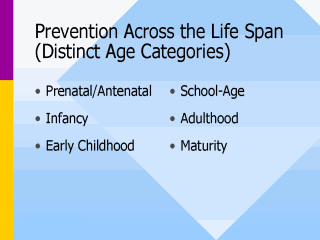| front |1 |2 |3 |4 |5 |6 |7 |8 |9 |10 |11 |12 |13 |14 |15 |16 |17 |18 |19 |20 |review |
 |
Resources for
Distinct Age Categories: A. Prenatal/Antenatal (Primary) Good health care and nutrition, and avoidance of toxic substances during the pre-conceptual time prepares a woman for a healthier pregnancy when she is ready to conceive. B. Infancy: Infant Hearing Screening (Secondary): Universal newborn hearing screening is an example of secondary prevention efforts. C. Early Childhood/School-Age: (Secondary): Preschool and kindergarten speech-language and hearing screening programs are examples of secondary prevention. Primary prevention for injuries includes seat belts, helmets, and fire safety. D. School-Age (Tertiary): With school-age children with hearing impairments, an example of tertiary prevention would be provision of habilitative activities (e.g., auditory training, speech reading, speech conservation). E. Adulthood (Secondary, Tertiary): Less common illnesses leading to communication disorders may begin to show signs and symptoms during adulthood (e.g., Parkinsonís, ALS, multiple sclerosis) calling for secondary and tertiary prevention efforts. F. Maturity (Secondary): The ultimate goal of a communication prevention program designed for elderly individuals is to improve or sustain their ability to communicate effectively in as many contexts of choice as possible. This includes early identification of symptoms that might be indicative of a communication problem or of factors that might contribute to deterioration of communication skills Transition Point: Health education prevention models can assist the audiologist and speech-language pathologist in establishing a prevention program... |